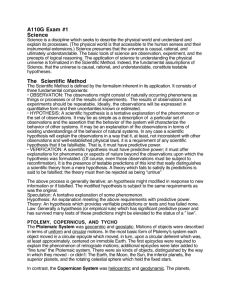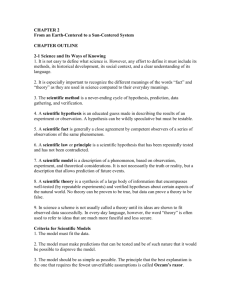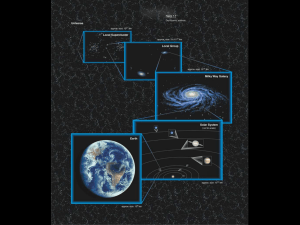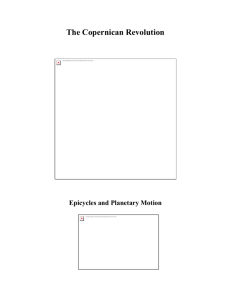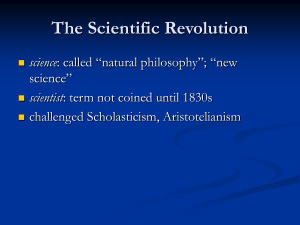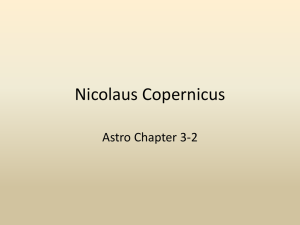The Copernican Revolution and the Size of the Universe
advertisement
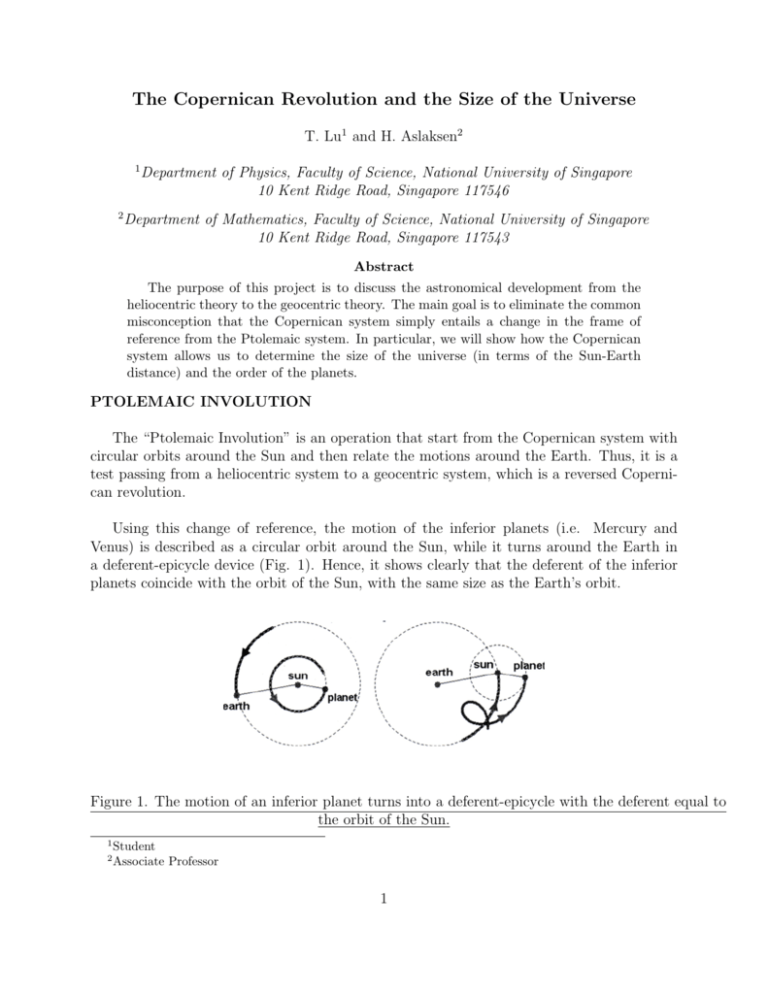
The Copernican Revolution and the Size of the Universe T. Lu1 and H. Aslaksen2 1 2 Department of Physics, Faculty of Science, National University of Singapore 10 Kent Ridge Road, Singapore 117546 Department of Mathematics, Faculty of Science, National University of Singapore 10 Kent Ridge Road, Singapore 117543 Abstract The purpose of this project is to discuss the astronomical development from the heliocentric theory to the geocentric theory. The main goal is to eliminate the common misconception that the Copernican system simply entails a change in the frame of reference from the Ptolemaic system. In particular, we will show how the Copernican system allows us to determine the size of the universe (in terms of the Sun-Earth distance) and the order of the planets. PTOLEMAIC INVOLUTION The “Ptolemaic Involution” is an operation that start from the Copernican system with circular orbits around the Sun and then relate the motions around the Earth. Thus, it is a test passing from a heliocentric system to a geocentric system, which is a reversed Copernican revolution. Using this change of reference, the motion of the inferior planets (i.e. Mercury and Venus) is described as a circular orbit around the Sun, while it turns around the Earth in a deferent-epicycle device (Fig. 1). Hence, it shows clearly that the deferent of the inferior planets coincide with the orbit of the Sun, with the same size as the Earth’s orbit. Figure 1. The motion of an inferior planet turns into a deferent-epicycle with the deferent equal to the orbit of the Sun. 1 2 Student Associate Professor 1 The problem of the superior planets, which was considered in the same way with the inferior planets, could be described as a deferent-epicycle system, but with an epicycle much larger than the deferent. To limit the size of the epicycle, a point C is induced to describe a circle around the Earth (E) with the radius of the planet (P) around the Sun (S) (Fig.2). In this way, we obtain a deferent-epicycle device, whose deferent is the orbit of the planet around the Sun and whose epicycle is the orbit of the Earth around the Sun. Figure 2. The motion of an superior planet turns into a deferent-epicycle with the deferent equal to the orbit of the Sun. However, based on the above system transfer, we realize the difference between the Ptolemaic system and the geocentric system obtained by referring the motions of the planets to the Earth. In the first place, the deferent of the inferior planets in the Ptolemaic system do not coincide with the orbit of the Sun. In addition, the epicycles of the superior planets in the Ptolemaic system do not have the radius equal to the Earth’s orbit. 2 Figure 3. The Ptolemaic system. The deferent of the inferior planets does not coincide with the orbit of the Sun, but the centres of their epicycles remain aligned with the Sun. The epicycle of the superior planets does not have the same size equal to the Sun’s orbit, but the line joining the centre of the epicycle to the planet is parallel to the Earth-Sun direction. If using this Ptolemaic involution (i.e. starting from the Copernican system and referring the motions to the Earth) we do not obtain the Ptolemaic system, it follows that passing from the Ptolemaic system to the Copernican system does not simply entail a change in the frame of reference. To pass from the Ptolemaic system to the Copernican system, a dilatation centred on the Earth to each deferent-epicycle device is needed to apply so that the deferent of the inferior planets and the epicycles of the superior planets come to the same size, that is the Earth’s orbit. PROFOUND SIMPLIFICATION Many simple historical accounts of the Copernican revolution emphasized not the accuracy but the simplicity of the new system, generally in contrast to the horrendous complex scheme of epicycles-upon-epicycles supposedly perpetrated by pre-Copernican astronomers. This statement reached its most heights in the 1969 Encyclopaedia Britannica, where the article on astronomy states that, 40 to 60 epicycles were required for each planet. More typically, we find what Robert Palter has called the “80-34 syndrome” - the claim that the simpler Copernican system required only 34 circles in contrast to the 80 supposedly needed by Ptolemy. But even Copernicus would have had difficulty in establishing an unambiguous final count. A comparison between the Copernican and the Ptolemaic system is more precise if we limit the count of circles to the longitude mechanisms for the Sun (or Earth), Moon, and Planets: Copernicus requires 18, Ptolemy requires 15. Thus, the Copernican system is slightly more complicated than the original Ptolemaic system. This contrast between the simplicity of the Copernican system and the complexity of the detailed Ptolemaic mechanisms proves to be entirely fictitious. However, unlike in the Ptolemaic scheme, the relative sizes of the planetary orbits in the Copernican system are fixed with respect to each other and no longer be independently scaled in size. This is certainly one of the most striking unifications brought by the Copernican system: a profound simplification. Maybe, like Copernicus says, Ptolemy has been able to invent a geometrical system more accurate than his, but the devices related to each plant can be expanded and shrunk at will and do not even allow them to determine the order of the planets. Contrary to the Ptolemaic system, Copernicus’s heliocentric theory not only explains that phenomena, but, furthermore, determines the order and the sizes of the planetary orbits. 3 CONCLUSION In this paper, we show that the chief point of Copernicus was that the heliocentric system allows us to determine the size of the universe and the order of the planets. ACKNOWLEDGEMENT I thank my supervisor H. Aslaksen for his teaching and meaningful discussions during my exchange study in National University of Singapore. References [1] Butterfield H. (1949), The Origins of Modern Science, Bell and Sons Ltd, London. [2] Dreyer J.L.E. (1906), A History of Astronomy From Thales to Kepler, Cambridge University Press, Cambridge. [3] Edward. R. (1971), “Nicholas Copernicus, a Biography”, Three Copernican Treatises, Vol 2(4), 90. [4] Galilei G. (1953), Dialogue Concerning the Two Chief World Systems, University of California Press, Berkeley. [5] Giorgio, G. (2005), “Copernicus Decoded”, The Mathematical Intelligencer, 12-30. [6] Kepler J. (1995), The Epitome of Copernican Astronomy & Harmonies of the World, Prometheus Books, New York. [7] Kuhn T.S. (1957), The Copernican Revolution - Planetary Astronomy in the Development of Western Thought, Harvard University Press, Cambridge, Massachusetts. 4
